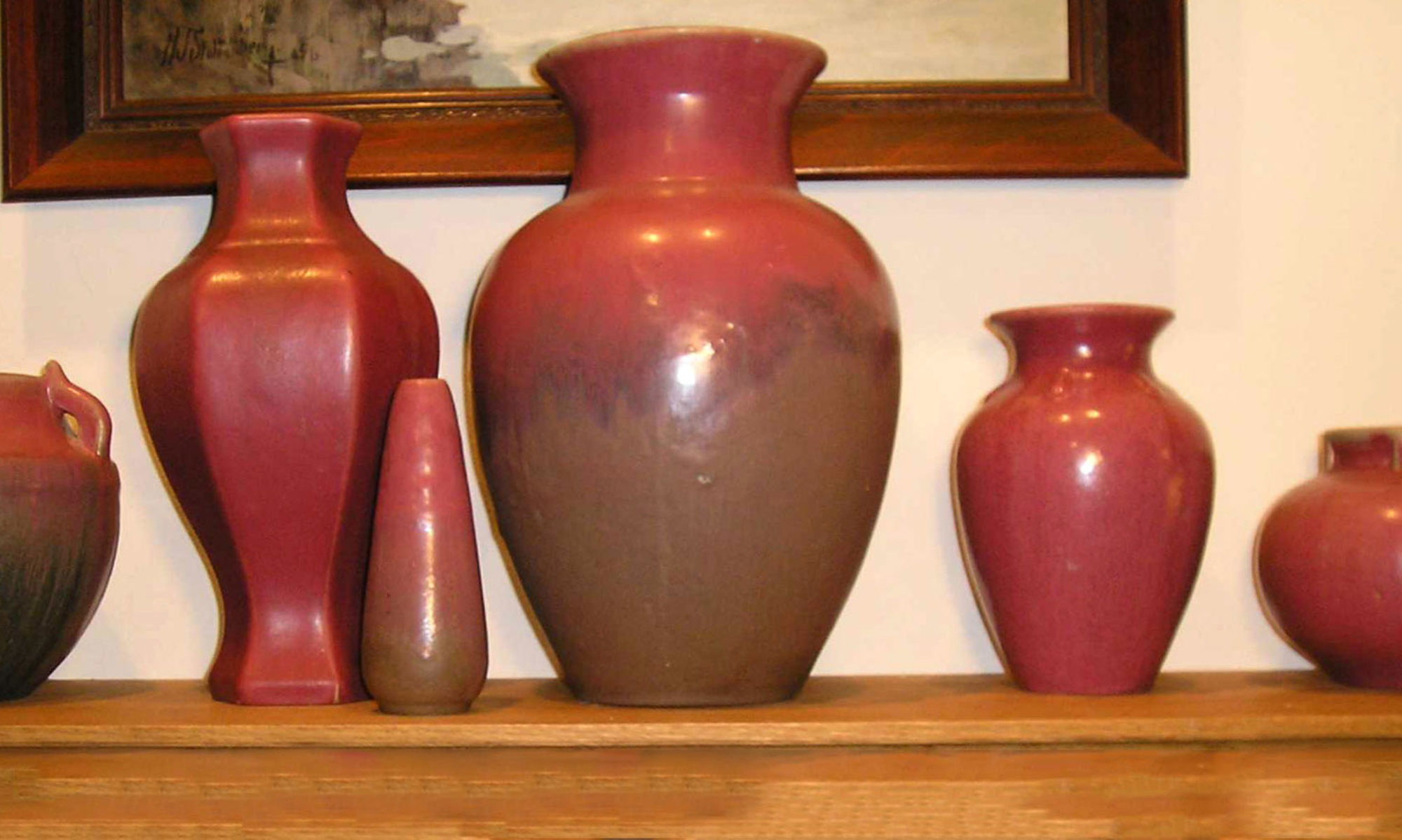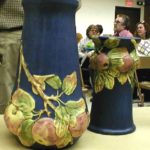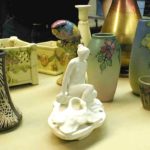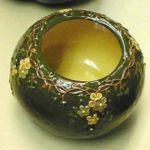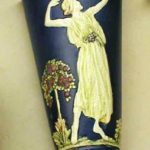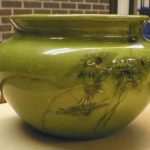1872-1948
Fultonham & Zanesville Ohio
The Weller Pottery was the first mass producer of art pottery. Samuel Weller was known for hiring great artists, and for his innovations. However, he also produced many so-called “mutant” pots – strange glazes and odd glazes for a given pot type.
At the March 2001 WPA meeting Chris Swart gave a wonderful presentation on Weller Art Pottery. Chris also organized our 2001 Show and Sale Exhibit on Weller and Company.
The following article appeared the WPA Press, Vol. 8, April 2001
By Kari Kenefick
The Weller Pottery was the first mass producer of art pottery. Samuel Weller was known for hiring great artists, and for his innovations. However, he also produced many so-called “mutant” pots – strange glazes and odd glazes for a given pot type.
Weller was not known for excellence in quality control. This article contains material from Chris Swart’s March presentation, as well as a few tidbits from other pottery references as listed following this article.
Samuel Augustus Weller was born on April 12, 1851 in Ohio. In 1872, the 21 year old Weller, a resident of Muskingum County, established the Weller pottery in a log cabin in Fultonham, Ohio (near Zanesville), complete with a beehive kiln. As business boomed he moved to Zanesville and built a new factory on the banks of the Muskingum River.
Weller was followed in his move to the river banks by many other potteries that went on to become household names, such as Roseville, J.B.Owens, McCoy, Watt, Hull, Brush and Robinson Ransbottom. The Weller pottery continued, as did many others, in this general location until 1931 when the Depression forced consolidations and down-sizing.
Sam Weller traveled to the 1893 World’s Fair in Chicago where he was so taken with the work of the Lonhuda Pottery of Steubenville, Ohio, that he offered to purchase the pottery from William Long. The following year Long sold his pottery to Weller and became a designer for Weller. Lonhuda pottery was continued by Weller’s firm and the incorporation of this product into the Weller pottery family is credited with launching Weller into the art pottery market.
Long’s tenure at the Weller pottery was short; he left in 1896. At approximately this time Louise Weller was born and the Lonhuda pottery line became Louwelsa. As with the Lonhuda pottery, Louwelsa featured a high gloss over beautifully painted flowers and background colors of blues, reds and greens, often in a gradient of light, bright color to very dark colors.
Weller pottery lines that immediately followed Louwelsa included: i) Dickensware in 1897, which was very similar to Louwelsa except that the background color was solid versus the gradient; ii) Eocean, first produced in 1898 through the 1920s, featured again the background gradient with colors of gray or olive green to ivory. Eocean Rose had a rosey tint over the ivory; iii)
Turada was developed by Henry Schmidt in 1897, as the first squeezebag pottery line in the Ohio valley (Tyrano was a similar and competing product produced by Owens Pottery in 1898); iv) Dickensware II (1890) was developed by Charles Upjohn, who headed the Weller decorating department from 1895-1904.
Many other pottery lines were developed at Weller, by an impressive number of talented pottery designers, whose names are too numerous to mention here. However, readers might appreciate the dates of a few standout potters in the Weller arena, including the fact that Jacques Sicard and an assistant were enticed to travel from France to Zanesville, OH, to produce glazes for Sam Weller’s pottery.
It is recorded that Sicard arrived in Ohio around 1900, although his Sicardo line was little known until it’s exposure at the 1904 St. Louis World’s Fair. Pieces made by Sicard featured his characteristic iridescent metallic finish and were often signed Sicard on the side of the vase. The Sicardo pottery was well received at the World’s Fair and even before that was selected by Tiffany’s as one of their product lines (1903). But Sam Weller felt that the glaze was too expensive and attempted to get the recipe from Sicard’s previous employer in France. When asked to pay for the recipe Weller refused.
Sicard left for France in 1907. It is estimated that Weller spent $50,000 on the Sicard/Sicardo venture, one in which only an estimated 30% of the ware came through the complicated firing and finishing process in marketable form.
Another iridescent ware potter, John Lessel went to work for Sam Weller in 1920. Lessel had been influenced by Owensart Opalesce, J.B. Owen’s answer to Weller’s Sicardo line. The Opalesce line was introduced in 1905 but soon disappeared. Lessel had already worked producing pieces with a plain yet metallic surface in 1903–04 for Arcen Ciel in Zanesville, OH.
The Lasa line that Lessel produced for Weller very closely mimics one of the opalescent lines of Owens’. Lessel was responsible for several of Weller’s most popular pottery lines, Lasa being the best known.
As stated by Chris during his presentation, Weller was the largest producer of art pottery in the world by 1905. Sam Weller developed a reputation for hiring the best, most creative designers, but also for attempting to steal their secrets.
In 1925 Sam Weller died at age 74. His nephew Harry Weller took over as president of the company, introducing the continuous kiln process, and consolidating the multiple plants in 1931, due to the Depression.
Harry Weller died in an automobile crash in 1932. During the years 1930–32 the last freehand decorated lines were introduced at Weller. These included Stellar, Geode, Cretone, Raceme, and Bonito.
Bibliography
In addition to notes from Chris Swart’s presentation, the following references were used for this article: Nelson, Marion (1988) Art Pottery of the Midwest.
Sigafoose, Dick (1998) American Art Pottery.
Chris Swart used All About Weller (1989) by Ann Gilbert McDonald, Art Pottery of the Midwest (1988) by Marion Nelson, and Art Pottery of the United States (1987) by Paul Evans to prepare his talk and the Weller timeline.
Gallery
WPA members brought in some of their collection to give a preview of the Wisconsin Pottery Association’s 2001 show Weller & Company.
Timeline
April 12, 1851–Samuel Augustus Weller born in Ohio
1872 –Operates a one-man pottery in Fultonham, near Zanesville in Muskingum County, Ohio
1882-1890 –Expansion to Zanesville, followed by building, buy-outs until 1931 when the Depression forces consolidation and down-sizing
1893-1896–William Long’s Lonhuda ware, Louise Weller and Louwelsa born, 1896
1897–Henry Schmidt develops Weller Turada, the first squeezebag pottery line in the Ohio valley, Owens Pottery introduces similar Cyrano line in 1898
1895-1904–Charles Upjohn heads Weller decorating department, develops Dickensware II in 1900
1902-1907–Jacques Sicard at Weller, Sicard line appears in the fall of 1903; (Clement Massier Reflets Metalliques by 1889)
1902-1905–Weller becomes world’s largest pottery and maker of mass produced Art Pottery
1903-1904–Frederick Hurton Rhead at Weller, develops Jap Birdimal line in 1904, becomes Roseville’s first art director in 1904, leaves Roseville in 1908
1904–Weller has huge display at the St. Louis Exposition
1908–Rudolph Lorber develops Dechiwo, 1908, which leads to Burntwood, Claywood, and others
1917–Weller Hudson family introduced
1916-1929–Rudolph Lorbor develops Brighton birds, Muskota, Woodcraft, Forest, Glendale and other great naturalistic lines, ending with Coppertone, 1929. Dorothy England Laughead creates Silvertone, Chase, and the Garden Animals
1920-1924–John Lessell heads the decorating department, develops luster glaze lines including LaSa, Marengo, Cloudburst, Lamar, others
July 1, 1922–Weller Pottery incorporated as “S.A. Weller, Inc.”
October 4, 1925 –Samuel Augustus Weller dies
1925-1932–Nephew Harry Weller takes over as president, introduces continuous kiln, consolidates plants in 1931 due to Depression, dies in auto crash in 1932
1930-1932–Last freehand decorated lines introduced at Weller: Stellar, Geode, Cretone, Raceme, Bonito
1932-1937–Frederic Grant, son-in-law, is president for one year, divorced from Ethel (Weller, b. 1898); Irvin Smith, another son-in-law (Louise) is president from 1933-1937
1935–Freehand decoration ends at Weller
1935-1948–Weller produces simplified embossed lines
1937-1948–Walter Hughes, a ceramic engineer and former employee at American Encaustic Tiling Company is Weller’s last president
1947-1948–Essex Wire Corporation buys controlling share in Weller, closes the pottery in 1948
1954–Minnie Weller dies at age 92, Weller house contents are auctioned
Related Sites: (These sites will open up in a new window)
Weller History – An article about Weller Pottery at Collectics.com .
Pottery Studio – A history article with links to some examples. Interesting link to information on Charlotte Rhead, the sister of Frederich H. Rhead a designer at Weller.
